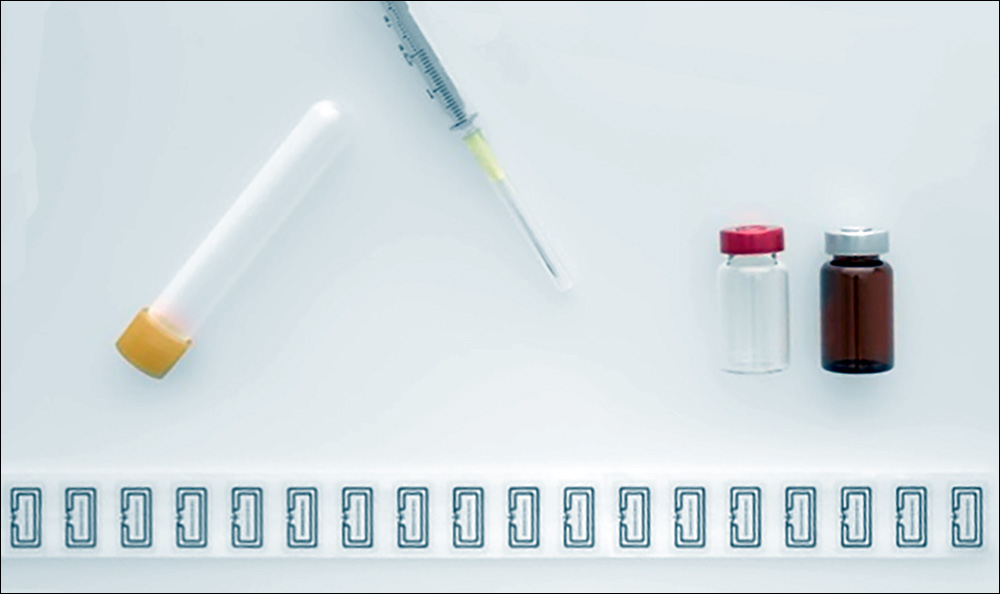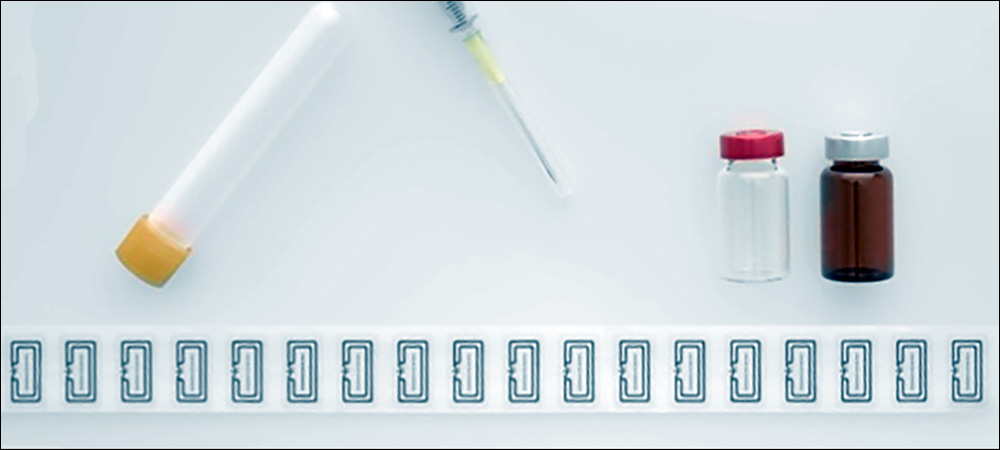French RFID label company Tageos has released a small-footprint UHF RFID inlay called the EOS-202 U9, designed for pharmaceutical tracking. According to the company, the new inlay is intended to serve any application in which tags can be applied directly to unit-of-use products, such as vials and syringes.
The company calls the EOS-202 U9 the smallest form-factor RFID inlay for healthcare and pharmaceutical applications. It measures 20 millimeters by 10 millimeters (0.79 inch by 0.39 inch) and has gained Dose-ID Consortium ARC Spec S certification from Auburn University’s RFID Lab. The inlay is intended to foster the adoption of RFID tagging for pharmaceutical companies and others in the healthcare supply chain, and it is now available in dry, wet and paper-face formats in large quantities.

The EOS-202 U9 inlays can be applied directly to vials, syringes and other drug products.
The use of RFID to automatically identify pharmaceuticals and devices is growing, the firm reports, with more drug companies tagging products at the point of manufacture. In fact, pharmaceutical customers are leveraging the inventory and supply chain tracking benefits that an RFID tag can provide by reading tags as goods are received, stored and administered. RFID solutions, such as Kit Check‘s medication-tracking system, enable companies to know where their products are located and when they are due to expire.
Dose-ID is a certifications body for tags in the pharmaceutical market. The consortium is working with Auburn’s RFID Lab to ensure new UHF RFID products meet the ARC Spec S specification for use with medicines and medical devices. However, there are few uniform tag options that serve all form factors. Due to the small size of single medication units, the presence of liquids in some cases, and the multiple surface materials—ranging from glass to cardboard packaging—there are few universal inlays that work for all products, says Chris Reese, Tageos’s head of product management.

Chris Reese
That, Reese explains, means label converters must build tags with a variety of inlays to meet each product’s requirements. In many cases, he says, labels that provide the highest performance are too large for the items they are being used to track. Because of challenges involving size and performance, tags are often applied to packaging rather than directly to products.
For the past three months, Tageos has been designing the EOS-202 U9 inlay to provide Spec S quality performance in a small form factor, the company reports. It leverages NXP‘s UCODE 9 IC and a small-footprint antenna design. The antenna measures 20 millimeters by 10 millimeters (0.8 inch by 0.4 inch), while a wet inlay with adhesive measures 22 millimeters by 12 millimeters (0.9 inch by 0.5 inch). With the UCODE 9 chip, the inlay provides features that include auto-adjust technology, unique brand identifiers and pre-serialized 96-bit Electronic Product Code memory.
The inlay has been tested across all types of items and materials according to ARC Spec S for healthcare and pharmaceutical applications, says Jeremy Wade, Tageos’s director of business development for the Americas, and has proven it can read tags at a rate near 100 percent. That performance quality is consistent, he adds, whether the tag is used on clear or amber liquid glass vials, clear glass powder vials, plastic or cyclic olefin polymer syringes, plastic syringe caps or plastic blow-fill-seal vials. Because of this versatility, the company expects the inlays to automatically identify single units at hospitals and pharmacies, as well as throughout the supply chain.
The Dose-ID Consortium, which helped to create the Sec S certification requirements, was founded by Kit Check, the largest provider of hardware and software used to read such tags in the healthcare environment. Spec S provides performance thresholds for pharmaceuticals used with Kit Check applications. Prior to the release of Spec S, Reese explains, multiple RFID solutions had been used to enable the tracking of medicines within healthcare environments, and the lack of a single universal specification made the rollout more complex. “Our objective,” he states, was to achieve Spec S standards with the smallest dimensions possible.”

Jeremy Wade
The new inlay “solves a couple of problems,” Wade says. It enables drug companies to accomplish labeling directly on their products, he explains, while allowing converters to buy one type of inlay for all their needs or purposes instead of having to source multiple inlays for very specific uses. Traditionally, converters often had to customize inlays for specific pharmaceutical customers; some might require very small labels, while others might need to apply wet inlays and others might prefer shrink-sleeve labels.
The company offers the inlays on rolls in one of two orientation options: either as a wide-edge leading format of the inlay, or as a narrow-edge leading, in which the inlay’s smaller edge matches the roll’s smaller edge. This provides converters with a choice for how to assemble labels using inlay rolls. Some converters require the narrow edge leading format for their label manufacturing process, Wade says.
Tageos reports that the new inlay enables high performance in its small size, based on its proprietary antenna design created in the company’s rapid product-development process. The 90-day design, in this case, required extensive work and testing in an anechoic chamber to meet the specification’s complex requirements, Reese says. The built-in UCODE 9 chip enables high sensitivity values, he notes, allowing for a smaller antenna and thus helping the inlay to achieve its small size.
Reese says several companies now have samples of the inlay in hand, which they are currently testing and using. Those businesses include converters, as well as pharmaceutical firms and systems integrators like Kit Check. Tageos expects to see commercially available labels using the inlays on the market by the fourth quarter of this year, and he reports that feedback from customers has been good.
Since its development, the EOS-202 U9 inlay has attracted attention from other markets for applications beyond pharmaceuticals and healthcare, Reese reports, including for tracking retail cosmetics. Some drug companies have reportedly been delaying RFID adoption until inlays were available that could accomplish the tagging of the entire range of materials they produce. “This helps the adoption process of the technology,” he states.


